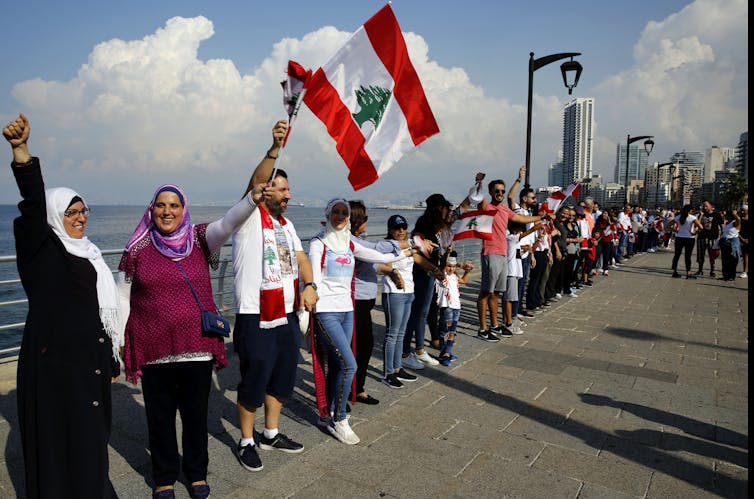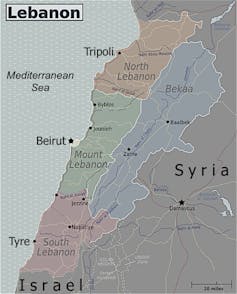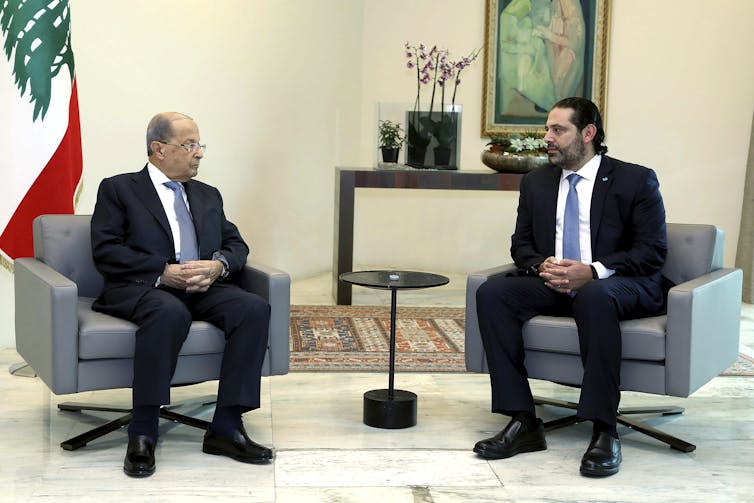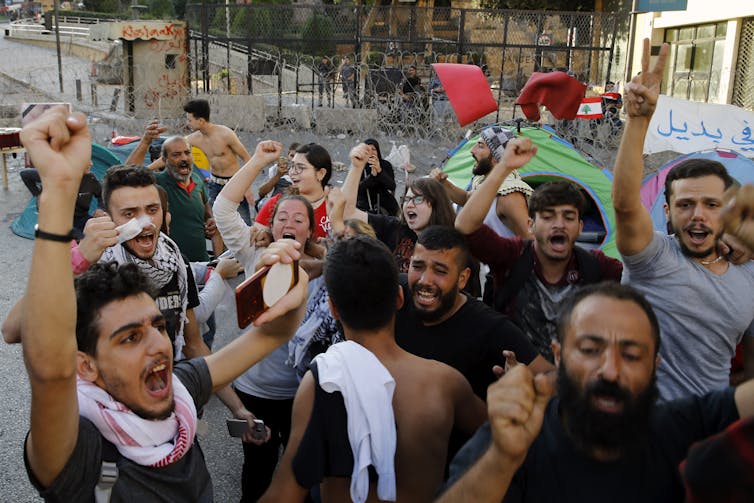In repudiation of the idea that religious allegiance comes before national unity, protesters are demanding fair elections, a stronger judiciary and more government accountability, writes Mira Assaf Kafantaris.

Religion has shaped Lebanon since it gained independence from France in 1943. In this multicultural country of Muslims, Christians and Druze – a medieval faith derived from Islam – religion defines membership and belonging. It is woven into Lebanon’s economic, political and social fabric.
The mass protests that began in mid-October over a proposal to tax WhatsApp calls are challenging that tradition. Over a million Lebanese from all faiths have joined together in these leaderless and nationwide anti-government demonstrations, in which the agenda has now expanded from avoiding taxes to regime change.
“All of them means all of them,” protesters nationwide chant, demanding the ouster of Lebanon’s entire ruling class.
On Oct. 29, Lebanese Prime Minister Saad Hariri, a Sunni, resigned, elating demonstrators. Protesters blame Hariri, along with Lebanon’s Christian president and Shiite parliament speaker, for rampant corruption, a wrecked economy and a ravaged environment.
In repudiation of the idea that religious allegiance comes before national unity, they are demanding fair elections, a stronger judiciary and more government accountability.

(AP Photo/Hussein Malla)
‘Hunger Has No Religion’
With 18 recognized sects – including the Maronite Christians; Sunni, Shiite and Alawite Muslims; and the Druze – Lebanon is one of the most religiously diverse countries in the Middle East.
When a class struggle broke out there in the mid-1970s, it quickly devolved into a civil war between right-wing Christian and left-wing Muslim militias.
To end Lebanon’s conflict, the 1989 Taif Accords required all factions to relinquish their weapons and distributed government positions to politicians of different faiths.

(Globe-trotter/Perry-Castañeda Library Map Collection – University of Texas Library Online, CC BY-SA)
This power-sharing agreement has kept the peace in Lebanon. But it has also given it a political order built on religious factionalism.
Patronage networks run by the “za’eem,” as Lebanon’s powerful sectarian leaders are called, protect the interests of their religious communities, doling out favors both legal and illegal. All faiths have their own za’eem.
Religiously based governance has given Lebanon both extreme national debt and staggering inequality. According to the World Inequality Database, the richest 1 percent of Lebanese own approximately a quarter of the nation’s wealth. Lebanon’s infrastructure is crumbling. Power outages are a chronic problem even in urban middle-class neighborhoods.
Widespread human rights violations – including domestic violence, child labor and abuse of Syrian refugees – are rarely punished.
But, according to the political scientist Bassel Salloukh, Lebanon’s rulers “use sectarian mobilization to camouflage intra-sectarian socioeconomic disparities” – a divide-and-conquer strategy meant to stop class solidarity from emerging.
The beneficiaries of this system argue that Lebanon’s stability hinges on this sectarian balance. And, indeed, sectarianism has been remarkably effective in forestalling dissent for the past 30 years.
It has also instilled a deep distrust in government. A recent poll shows that 96 percent of Lebanese think political corruption is endemic.
The Sectarian Construct
As a literary historian, I study the stories a nation tells itself about belonging, allegiance and identity. In Lebanon, my home country, I recognize sectarianism as a social construct.
Social constructs, like civility or money, are concepts that only mean something because humans agree they do. Often, social constructs benefit the powerful.
By drawing the boundaries of inclusion along religious lines, Lebanese sectarianism has impeded the rise of more unifying ideologies like nationalism or secularism.
“Sectarianism has been depicted as a monolithic force, unchanging in the face of history,” historian Ussama Makdisi wrote in his 2000 book “The Culture of Sectarianism.” But, he continues, “sectarianism was produced. Therefore it can be changed.”
Since the civil war, Lebanese have been raised to see religion as the only marker of kinship and rivalry, but the Lebanese share many things: a multilingual literary heritage, for example, and a love of Fairuz, one of the Arab world’s most admired singers.
Lebanese of different faiths suffer together, too. As one protester told Foreign Policy, hunger has no religion.

Sectarian politics have been dismantled before. Two decades after Northern Ireland’s Good Friday Agreement, the divide between Catholics and Protestants there remains. But it is official government policy to foster peace-building, human rights and religious freedom.
Like protesters in both Tunisia and, more recently, Sudan – who pushed out religiously divisive leaders in hopes of nurturing a more secular democracy – Lebanon’s protests challenge a tired western stereotype that the Middle East is an intolerant, naturally authoritarian place.
Hezbollah No Exception
In recent days, demonstrators who support Hezbollah have protested the inclusion of their leader, Hassan Nasrallah, in the movement’s calls for regime change. They say accusations of corruption against this powerful Lebanese political and social force are evidence of a conspiracy by Saudi Arabia, Israel and the United States.
Violence erupted on Oct. 29 when Hezbollah supporters attacked demonstrators, re-opening key roads blocked by protester encampments and setting their tents on fire.
Still, the uprising grows. Past violence has failed to quell protests, as have offers from the government to cut lawmakers’ salaries by half and tax banks to relieve national debt.
Prime Minister Hariri’s resignation opens the door for real change in Lebanon, but protests will likely continue. The za’eem system means Hariri’s replacement may well reinforce the same power-sharing model.

The current grassroots protests build on the momentum of a 2015 uprising called the #YouStink movement. Those protests began when Lebanon’s main landfill was shut down and mounds of trash filled the streets of Beirut, but they came to embody numerous other causes: Children marched for climate action. Feminists defended the rights of domestic workers.
In 2018, women ran for office in Lebanon record numbers.
Rebuilding a Nation
There is an academic theory I like about how nations are built, called “cultural intimacy.”
It holds that communal acts like breaking bread together, say, or self-deprecating humor play a crucial role in creating a shared citizenry.
The 1.5 million Lebanese Sunnis, Shias and Christians who have for weeks been walking side by side, holding hands and raging against the system are not merely protesting. They’re building a society that works for them.
Mira Assaf Kafantaris is senior lecturer in English at The Ohio State University.
This article is republished from The Conversation under a Creative Commons license. Read the original article.
Before commenting please read Robert Parry’s Comment Policy. Allegations unsupported by facts, gross or misleading factual errors and ad hominem attacks, and abusive or rude language toward other commenters or our writers will be removed. If your comment does not immediately appear, please be patient as it is manually reviewed. For security reasons, please refrain from inserting links in your comments.

Thank you Mira for an honest assessment of the Lebanese culture. Here in the US we receive so little truth.
Years ago, because of an odd musical association I became friends for a time (until his wife didn’t like me) with one of the 1% Maronite elite gentleman. He was shocked that I knew about Chateau Musar and Chateau Khafria. Because of my interest he educated me a bit in Lebanese culture. Since then I have followed developments there.
Lebanon is predominantly a country of modern, educated, multilingual people.
I particularly liked the protesters idea of cutting government workers salaries and benefits in half. Comparing the public sector to the private sector in the US it’s likely that the average salaries + benefits of full time federal employees are greater than any society in the history of mankind.
I’m surprised by the lack of comments here about this amazing protest that is helping to bring hope to an increasingly hopeless situation in Lebanon and stimulate a real unification, and possibly become an example for the Middle East. I have two questions for anyone willing to respond: Is there hard evidence that Iran has been funding Hezbollah all these years to foment division amongst the sects of Islam in Lebanon and as a strategy for annoying Israel?
Let’s hope the “All of them means all of them” spreads across the world, especially to Big Daddy USA, the one main usurper of our personal information and of the world’s resources.